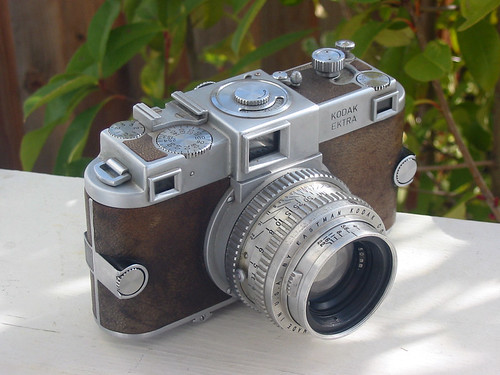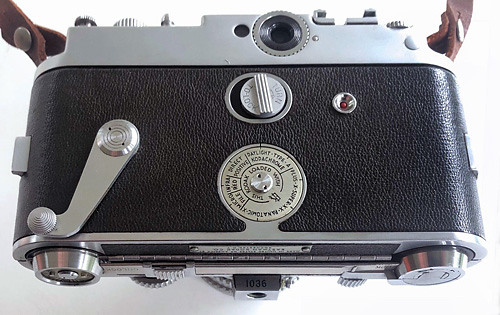Kodak Ektra
This article is about Kodak's 35mm camera from the 1940s. Kodak later reused the Ektra brand on inexpensive cameras for 110 film.

|
| image by Coleccionando Cámaras (Image rights) |
The Ektra is a very advanced 35mm rangefinder camera launched by Kodak USA in 1941. Before World War II, Kodak presented some really advanced cameras under the supervision of Joe Mihalyi, among which the Medalist, Super Six-20 and Bantam Special.
The Ektra is a 35mm coupled rangefinder camera. The shutter is of the focal plane type, with speeds from 1 to 1/1000 second, plus 'B', with horizontally travelling cloth curtains. The Ektra has a system of interchangeable magazine backs, allowing to change film in the middle of a roll. The advance lever is at the left of the magazine back, and needs two strokes. The release button is at the left of the top plate. It has been said that Mihalyi was left-handed, so all the camera was designed to be used by a left-handed person. However this theory is contradicted in notes on the camera at Chicago Photographic Collectors' Society.[1]
The viewfinder incorporates a zoom device, from 50 to 254mm. Only the 35mm lens needs an external lens to be put in front of the finder. The viewfinder also has a dioptric adjustment, from -3 to +3 diopters. The rangefinder of the Ektra has a very large base, but is not integrated in the viewfinder.
The Ektra has interchangeable lenses with a breech lock mount engaging a fine screw thread. All the lenses are named Ektar:
- 35/3.3
- 50/1.9, seven element
- 50/3.5, four element
- 90/3.5
- 135/3.8
- 153/4.5
All the lenses are coated, early ones only on the internal surfaces, and later on all the lens elements. A 254mm lens was planned but was apparently never produced. About 2000 of the 35mm, 90mm and 135mm were made, and 400 of the 153mm. The lens cases are very nice cylindrical aluminium boxes.

|
| image by Benjamin C (Image rights) |
An Ektra was sold at Christie's with lenses including a 50/1.9 and a 90/3.5 marked Television Ektanon instead of Ektar.[2] According to notes at Golden Age Television Recreations, these lenses were adapted for some RCA television cameras.[3] The notes state that the lens mounts were adapted to fit the TV cameras' lens turret, but in the example at Christie's, the 50/1.9 lens is mounted on the camera body, so either this is incorrect (i.e. no adaptation was required) or some TV Ektanon lenses were sold unadapted.
A lens marked Wollensak-Dumont 50mm f/1,5 Raptar was been offered at auction by Breker.[4] It is described in the auctioneer's notes as perhaps a prototype lens for the Ektra, made to a Steinheil lens design. However it has no focusing ring and a 40.5mm screw mount, so is not a functional lens for the Ektra.
Accessories for the Ektra include:
- waist level brilliant finder (shoe mounted)
- angle finder (shoe mounted)
- magazine back
- ground glass back
- flash unit
- close focusing rangefinder
- synchronized flash
- tripod clearance head
About 2500 Ektra were sold, and it was advertised until 1948.
An improved version called Ektra II was planned, three of them are known to exist. They incorporate a built in lens for the 35mm lens, and can mount a magazine back with a spring driven motor.

|
| Ektra magazine back showing film winding lever. image by John Pierson (Image rights) |
Notes
- ↑ 'The Experts and the Eastman Kodak Ektra Camera', article by K. Kekatos at Chicago Photographic Collectors' Society
- ↑ Ektra outfit including body serial no 3609 and both 50/1.9 and 90/3.5 Television Ektanon lenses, sold at Sale 9777: Cameras and Photographic Equipment the Property of Dr S.M. Sorrell, on 1 April 2003.
- ↑ See Kodak equipment offered for hire at the Golden Age Television Recreations (archived).
- ↑ Wollensak-Dumont 50/1.5 Raptar, described as a prototype for the Ektar, to a design by Steinheil; sold at the sale Photographica and Film, on 30 September 2006, by auction Team Breker (listing at the LiveAuctioneers site).
Links
- The Kodak site by Brian Wallen has great info about the Ektra, with detailed pictures of the Ektra and Ektra II
- The Ektra at Cameraquest
- The Ektra at Pacific Rim
- Tales of the Kodak Ektra, an article by K. Kekatos at the Chicago Photographic Collectors Society
- US patent: Shutter of the Ektra
- Instruction manual for the Ektra at www.orphancameras.com
- Examples offered for sale at past auctions by Westlicht Photographica Auction:
- Ektra serial no. 1897, sold at the Camera Auction 23, on 25 May 2013.
- Ektra serial no. 1227 and Ektra serial no. 3786, offered for sale at Camera Auction 26, on 22 November 2014.